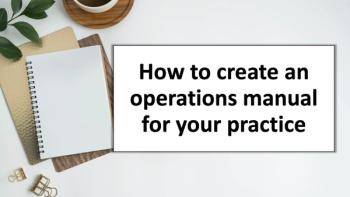
Streamline Patient Visits
Tips for making waits shorter and visits longer
As patient "face time" with physicians is increasingly whittled away -- down to a scant 10 minutes in some practices -- the amount of bureaucracy and wait time that patients must contend with continues to grow. Practice managers report that it is not unusual for patients to spend an hour in the practice, only 30 percent of it with their physician. Ironically, physicians note that a portion of this precious face-to-face time is often spent managing patient anger over having to endure the frustrating cycle of noncare activities.
Improving efficiency means eliminating unnecessary patient delays, managing and coordinating patient care before and after the visit, and safeguarding the physician-patient interaction so it remains dedicated to care delivery (not administrative chores such as chasing X-rays or lab results). Contact time with staff must be efficient, with all necessary steps swiftly executed, for a streamlined patient visit - from check-in to check-out.
Cutting patient wait time and smoothing patient flow is done with a scalpel, not a sledgehammer. You have to carve out tiny swatches of wasted time from numerous daily interactions. Consider the following steps, each of which could shave at least two minutes of wait time for your patients.
Standardize procedures
Practices lose time when different people do the same task in different ways -- particularly in practices that employ a large number of part-timers. Accommodating each person's work idiosyncrasies slows down all aspects of care.
Is there a standard exam preparation routine such as taking height, weight, and blood pressure in your practice? Be consistent in how you handle check-in and check-out procedures, referrals to ancillary services, appointments with other physicians, prescription refills, and dispensing medication samples.
Set up all exam rooms in the same way, with standard supplies and forms in the same place, so nurses and providers know what to expect no matter where they are. Most importantly, set up standard protocols for handling emergencies, so sick patients are not forced into the schedule, but anticipated.
By standardizing basic processes, you'll have time to put in place more sophisticated tactics to smoothly manage two patient flow tracks -- routine healthcare and episodic care based on patient need -- so that neither one derails the other. For instance, practices can extend on-call duty to office hours, not just nights and weekends, and make sure the on-call provider has slots available to take people who must be seen quickly. Also, consider using nurse practitioners or physician assistants to screen patients.
Appoint a flow coordinator
A streamlined visit requires minute-by-minute management to ensure patients are served and clinician needs are met. Many practices are appointing a flow coordinator to synchronize the interactions between medical assistants and front-desk staff. The coordinator's responsibility is like that of a restaurant maitre d' - minimizing delays by understanding each physician's schedule; anticipating and resolving potential flow glitches; ensuring that the front desk alerts patients to any significant snags; maintaining optimum medical assistant coverage in all exam room areas; and promoting enhanced communication between exam room areas and centralized support services (such as check-in, check-out, nursing triage, and medical records). The flow coordinator also should be able to assign rooms and resources in accordance with volume demand.
The configuration of your facility may make the coordinator's job all the more imperative. For example, if your office is divided into pods, that can promote harmonious interactions between medical assistants and clinicians, but tends to constrain patient and information flow.
Minimize conflicting staff roles
Practices need the appropriate number of staff to support delivery of service, but also must ensure that staff roles don't result in conflict or overlap. Staff schedules must be flexible to allow them to work with providers who have office hours in the early morning or evening, or are on-call for emergency visits. Tasks associated with specific positions, like schedules, must also be structured so that staff is available to do what needs to be done.
Just as the medical assistant helps control patient flow in the clinical area, the receptionist controls patient flow in the waiting room. If the same person also answers phone calls while checking in patients, there will inevitably be delays - and patients will feel neglected.
Pre-plan the visit
Moving a high volume of patients through a practice requires careful and meticulous visit planning -- especially in pediatrics, for instance, where 60 percent of daily volume can consist of same-day appointment requests. Pre-visit planning plays a huge role in practice efficiency and cutting dead time. It can also result in quantum increases in physician productivity.
Some suggestions: Have telephone staff ask new patients to complete health questionnaires at home instead of in the office; have nurses conduct phone assessments of patient needs pre-visit to determine scheduling requirements, length of visit, and other necessary resources, such as translation services and exam room needs; and set up a telephone triage system to screen requests for same-day appointments.
Pre-planning the patient visit shifts routine tasks from clinicians to the administrative staff, which allows for improved physician support and results in more coordinated care. For instance, front-desk staff can prepare patient labels for ancillary tests at check-in. When medical assistants and providers prepare labels during the exam, it distracts from other tasks and slows patient flow. Further, front-desk staff can prepare laboratory requisitions for clinical staff to use. If practice leadership can develop and agree to protocols, about 80 percent of all requisitions can be prepared at the front desk, based on the appointment type and reason for visit.
Pre-visit planning also will provide an opportunity to avoid managing in real time what does not have to be managed in real time. Have consent forms prepared for patient and provider signatures prior to the visit. Have referral protocols in place so that patients are contacted after the visit to process referrals to specialists, rather than monopolizing staff time and clogging patient flow.
Start the session off right
Many times sessions are doomed to run late before they even start. Staff and clinicians should arrive at least 15 minutes before the first patient scheduled. Failure to start on time throws off the entire day's schedule. Define the appointment time, including start time, end time, and duration. This includes communicating to the patient the need to arrive 10 minutes prior to the appointment. Appointment consistency is critical, particularly in academic medical centers, where physicians have multiple commitments.
At many practices, providers and clinical support staff do the "huddle" before each morning and afternoon session. Before the door opens, they briefly review who is on duty and the caseload for the day. They work to anticipate and prepare for patient needs, such as Pap smears and immunization set-ups, as well as to identify the need for special assistants. This kind of verbal communication promotes team morale and starts everyone off on the right foot.
Nonverbal communication is a great way to complement this effort. Using a signal system of lights, or simple colored flags, physicians and assistants can tell if there is a patient in the room, who is next, if someone needs an immunization or escort, or if the room needs to be cleaned. This can save volumes of time. While many practices have invested in light or flag systems, they often are inconsistent or never used. Put yours to work.
Minimize disruptions
There should be no interruptions during physician time with patients, such as taking phone calls, or leaving to find X-rays, patient educational materials, drug samples, or a medical assistant or nurse.
Prepare and use a standard protocol delineating how these situations should be handled in a way that doesn't interrupt the physician or the flow of patients. For instance, in certain situations, patients calling in an emergency can be instructed to call the Emergency Department directly and nurses can triage urgent requests without consulting the physicians. Visit preparation protocol can delineate how to stock the exam room in anticipation for certain visit types, such as suture removal, thereby eliminating the physician's need to leave the room to request or fetch supplies.
Make tools accessible
In many practices, staff must leave their workstations and walk between the front desk, laboratory, and workstations to retrieve and deliver information. Staff absences from their primary work areas disrupt patient flow and can be minimized by equipping workstations with personal computers and printers; using online scheduling to continually communicate schedule status, including patient arrival, cancellations, patient add-ons; and delivering medical records to the clinician area in advance of the session.
Put technology to use
Consider using your information technology (IT) as a tool in patient flow. In addition to record keeping and billing, computerized systems can help minimize traffic jams. Ask your IT vendor for information on new techniques or offerings to streamline patient flow. There are inexpensive features, for example, that notify staff when a patient has arrived. Keep patients moving by using your system to automatically schedule lab work and other procedures, print labels for prescriptions and refills, or request medical records.
Use order sheets and computer notes to communicate next steps so the provider does not have to speak directly to staff. Use preprinted labels, automated forms, and flow sheets (custom designed or purchased) to cut down on the time required to hand-write items (and reduce the risk that they will be illegible).
Your staff has a pivotal role in implementing any of these steps, reducing wait time, and smoothing patient flow. Their job is to support both physician productivity and the delivery of quality patient care. It is, after all, the physician-patient encounter that generates revenue, and staff must be wholly dedicated to making sure physicians are productive and meeting performance benchmarks. A tight and streamlined patient cycle helps reduce stress and tension, as well as the noise level emanating from chaotic and confusing patient flow. Not only are providers and staff more comfortable and effective, but the quality of patient care delivery takes a huge jump forward.
Debi Croes can be reached via
This article originally appeared in the June 2003 issue of Physicians Practice.
Newsletter
Optimize your practice with the Physicians Practice newsletter, offering management pearls, leadership tips, and business strategies tailored for practice administrators and physicians of any specialty.




